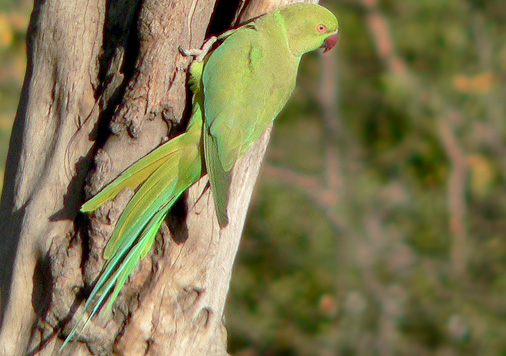| Kingdom: Animalia Phylum: Chordata Class: Aves (Birds) Order: Psittaciformes Family: Psittacidae | |
 Rose-ringed Parakeet (Psittacula krameri) - photo © Rajiv Lather
Identification: A parrot with generally green plumage. Yellowish under wing and lower abdomen. Long bluish-green tail, tipped with yellow. Sharp, deeply hooked red beak. Pale yellow eyes. Green-grey legs. Male: Black across chin and lower cheek. Rose-pink collar. Female: No black on chin and cheeks. No rose-pink collar. Shorter tail than male. Juveniles: Similar to female. Coral-pink beak. Grey-white eyes. Grey legs. Two subspecies; The north Indian P. krameri borealis (lower mandible red) and the south Indian P. krameri manillensis (lower mandible black). In addition to the two Indian subspecies, there are two African subspecies; African Rose-ringed Parakeet (P. k. krameri) and Abyssinian Rose-ringed Parakeet (P. k. parvirostris). Call: Screeching when flying or perching. Quiet whistles and chattering when roosting. Distribution: India, Bhutan, Nepal, Afghanistan, Sri Lanka, Pakistan, Bangladesh, Myanmar and North Africa. Introduced to Mauritius, South Africa, Arabia, the Middle East, Hong Kong and Singapore. Feral populations in Britain, USA and Europe. Common near farms and plantations and where there are trees. Habits: Noisy birds continually screeching. Usually live in small flocks but if food in abundance may gather in one place in the thousands and do damage to crops, fruit and coffee plantations and sunflower crops. Flight is direct and swift with rapid wing-beats. Food: Seeds, grains, chillies, fruits, berries, blossoms and nectar. Breeding: In India, January - May. In Africa, December - April. Nest: High up in holes in trees, under roofs, and in holes in walls. Old nest holes of other birds are enlarged and used. Eggs: 3-5. Eggs measure 30.7 x 23.8 mm. Incubated by the female for 22 days. Chicks: Naked and pink with yellow beaks. Leave the nest 7 weeks after hatching. Males moult twice and have adult plumage at 3 years old. |
|
 birding.in
birding.in
| Birds | Bird Diagram | Ornithology | Indian Sites | Bird Watching | Migration | North India | Birds of India | Haryana |
All rights reserved. Copyright © 2005-2013 Birds and birding in India. Disclaimer
website: Free Java Guide & Tutorials